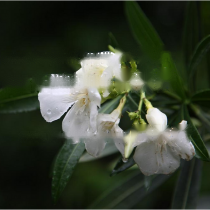
Chinese name: White Flower Oleander
Latin name: Nerium indicum Mill. cv. Paihua
Kingdom: Plant Kingdom
Door: Angiosperm
Family: Apocynaceae
Genus: Nerium
1. White Flower Oleander Morphology
The oleander is an evergreen upright large shrub that can grow up to five meters in height. The branches are gray-green and have water. Young shoots are ribbed and hairy, and shed only in old age. There are three or four whorled leaves, the small branches are opposite, relatively narrow, lanceolate, the top is relatively sharp, the root is wedge-shaped, the shape of the leaf margin is revolute, the length is 11 cm to 15 cm, and the width is Two centimeters to two and a half centimeters, the leaf surface is dark green without fluff, and the back of the leaf is light green with many depressions. The midrib is recessed on the leaf surface, raised on the back of the leaf, the lateral veins are flat on both sides, slender, dense and parallel, up to 120 on each side, reaching the leaf margin; the petiole is flat, slightly wider at the base, 5-8 mm long.
2. Habits of White Oleander
Oleander is generally divided into safflower oleander (Nerium indicum Mill.), yellow oleander (Thevetia peruviana ( Pers.) K.Schum.) and three species of oleander, of which oleander is an artificially cultivated variety, distributed in all parts of north and south China, most common in Yunnan, Guangdong, Guangxi, Hebei and other places, mostly born in Botanical gardens and parks. White-flowered oleander likes a warm and humid climate and is not very hardy to cold. It can be planted in the open field in the south of the Yangtze River in China, but in Nanjing, sometimes the branches and leaves freeze, and the seedlings even freeze to death. In the north, it can only be planted in pots for viewing, and overwinter indoors. The white flower variety is slightly more cold-tolerant than the safflower variety: oleander is not resistant to water and humidity, so it is required to choose a high dry place and a well-drained place for planting. It can also adapt to a more shady environment, but the flowers planted in the shade are few and light. It has strong tillering power and is easy to recover after the tree is damaged.
3. Planting of white oleander
The white oleander can be harvested and sown when it is ripe, and it can only emerge after 3 months in the greenhouse, and it can be sown in the open field in autumn The next year's Qingming Festival can emerge one after another. If it is a cutting, the seedbed should be selected as a seedbed with leeward sun, no water accumulation, less soil disease, insects and weeds, sufficient fertility and easy management. Generally, the seedbed should be in an east-west direction, and no matter which method is used for cutting seedlings, the soil must be carefully prepared. Generally, the depth of cultivated land should reach 25 to 30 cm, the bed width should be 1 meter, the length should be suitable, and the width of the trail should be 50 cm. When the soil is too sticky, add sand appropriately and pay attention to soil disinfection
Guess you like it
pike fishgrass | thick plum | aster | delphinium | Winter Red | Fei Cai | Feng Lan | Fengdan | | mallow | chive orchid | chive lotus | helichrysum | | Meadowsweet | Red lilac | Canna | Flower blue | Red water lily | Arabian mother-in-law | | Clary weed | Fragrance vine | Coral vine | Clock flower | Water stone ficus | Echinacea |
![[Dog Training 5] The training method of pet dog dining etiquette](/static/img/12192/12192_1.jpg)




